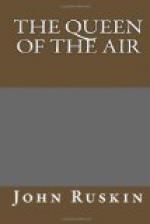78. Next we take the nuts and apples,—the nuts representing one of the groups of catkined trees, whose blossoms are only tufts and dust; and the other, the rose tribe, in which fruit and flower alike have been the types to the highest races of men, of all passionate temptation, or pure delight, from the coveting of Eve to the crowing of the Madonna, above the
“Rosa
sempiterna,
Che si dilata,
rigrada, e ridole
Odor di lode al
Sol.”
We have no time now for these, we must go on to the humblest group of all, yet the most wonderful, that of the grass which has given us our bread; and from that we will go back to the herbs.
79. The vast family of plants which, under rain, make the earth green for man, and, under sunshine, give him bread, and, in their springing in the early year, mixed with their native flowers, have given us (far more than the new leaves of trees) the thought and word of “spring,” divide themselves broadly into three great groups—the grasses, sedges, and rushes. The grasses are essentially a clothing for healthy and pure ground, watered by occasional rain, but in itself dry, and fit for all cultivated pasture and corn. They are distinctively plants with round and jointed stems, which have long green flexible leaves, and heads of seed, independently emerging from them. The sedges are essentially the clothing of waste and more or less poor or uncultivated soils, coarse in their structure, frequently triangular in stem—hence called “acute” by Virgil—and with their heads of seed not extricated from their leaves. Now, in both the sedges and grasses, the blossom has a common structure, though undeveloped in the sedges, but composed always of groups of double husks, which have mostly a spinous process in the centre, sometimes projecting into a long awn or beard; this central process being characteristic also of the ordinary leaves of mosses, as if a moss




